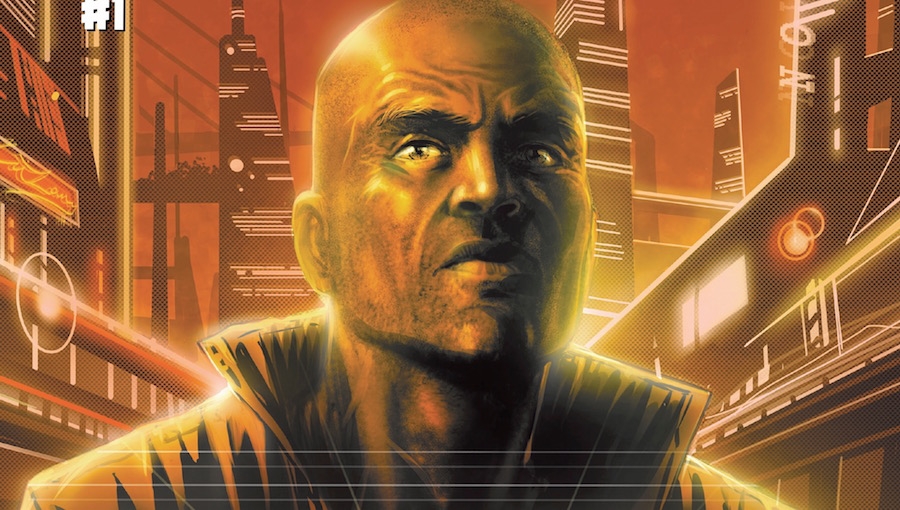Imagine in the near future, a world in which technology has been developed that will end death and suffering through loss. Getting there, though, will cost the lives of 30 million people, raising philosophical questions regarding mortality and heated religious debates accusing corporations of playing god. This is the setting of The Resurrected, the first comic book series from a new independent publishing company, Carnouche Productions.
Originally from Sydney, Australia, writer/creator Christian Carnouche opens his narrative with a brief history of the aborigines’ population decline as a result of British colonialism beginning in 1788. Fast forward to 2032, and readers are introduced to policeman Cain Duluth of aboriginal descent. While he has taken a position on Nova Lucis, an island off the coast of New York, his wife continued to work at Drexler, an Australian nanotechnology corporation. An explosion kills Cain’s wife and decimates 90% of the Australian population, including their daughter Yindi. The loss is devastating for Cain, and he carries the grief and guilt of losing them. As commemorations for the fifth anniversary take place, Cain and his partner Akimi work to solve a murder. They quickly find this case puzzling and dangerous.
Carnouche stated at the publisher’s website that in The Resurrected, he “delves into social-political issues, most significantly the ongoing destructive effects that the centuries-old invasion of Australia has had on the Indigenous population.” The historical reference provides the context for the tragic and fairly short timeframe – less than 250 years – to decimate the indigenous peoples of Australia. It provides the framework to follow along with Cain as he rediscovers his roots in subsequent issues of the series. The Resurrected blends themes of tradition and progress – from the historical narrative that opens the first issue to ideological differences between Cain (traditional) and Akimi (modern/progressive). They are often cast in juxtaposition to each other through their verbal interactions and through ways in which they interact with technology. For instance, while their banter is friendly, there is the undertone that Akimi is frustrated by Cain’s lack of engagement with technology at inopportune times that is detrimental to their police case and their superiors’ expectations to solve the case at hand. Carnouche, through a flashback, sets up that Cain was possibly resurrected (individuals who died but were given a second life); Cain has already expressed he believes that death should be permanent. This leads readers to assume that Cain will soon struggle with his personal identity in addition to discovering his aboriginal roots. Carnouche expertly casts Cain on his hero’s journey.
Joining Carnouche is artist Crizam Zamora, colorist Salvatore Aiala, letterer Cardinal Rae, and editor Erica Schultz. Zamora assembles a variety of panel layouts that keep the visual narrative fresh and engaging for the reader. The panel frames are clearly demarcated by thick frames, so the visuals do not blend and important story cues are not lost. The full-page spotlights punctuate critical moments in the story, such as the decimated Sydney Harbor and when Xander Calypse remembers how the loss of his mother impacted his destiny and goals for his corporation, Drexler. Zamora opens up the page format to showcase action, especially in the climatic cliffhanger. The only issue is that on occasion, the characters appear flat; a bit more pen and color shading would help in those instances. Speaking of color, Aiala hits on a color palette that presents moods that accentuate the narrative that is unfolding on each page. For example, readers get a sense of the depression and despair that Cain feels as he revisits the last moments before his wife’s death. In this scene, Aiala hits on a blend of blues and greys that reflect the light from a television screen in the dead of night.
Rae clearly delineates location/time stamp text, narrative voice-over, dialogue, and sound effects. There’s reason to how each is portrayed, such as the pointy dialogues with blue font text and blue-outlined speech balloons where a communications device is employed during a conversation between Cain, his wife, and his daughter. All of the text is well placed in the panels; the visual experience worked with both the readers’ eyes and the action taking place in the panels. Additionally, Rae has expertly utilized smaller text font to denote a character speaking under his breath – it’s that kind of attention to detail that is often overlooked as a technique at a letterer’s disposal to make the dialogue more robust. Schultz’s editing was seamless. The dialogue read smoothly and was paced well.
According the publisher’s website, the first issue has been completed. Pre-orders will be managed through crowdfunding next month on Kickstarter. If you are interested in reading this comic, when you join the publisher’s mailing list, you can read a preview. A PDF of the comic is scheduled to be available in April, and the physical copy is expected to follow up in June. For readers interested in stories that weave a character’s journey into a murder mystery while addressing complex issues of mortality and technological responsibility, then look no further: The Resurrected is it.

